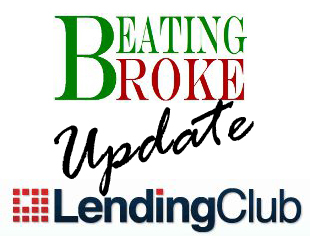It’s been a little while since I last wrote one of these updates. January of 2015 to be exact. Needless to say, there have been a few changes in my peer-to-peer investing in the last year and a half. One of the biggest changes, I’ll talk about below. First, let’s see where my peer-to-peer investing was when we last looked at it. (You can read the full post here, or just read the recap below.)
Peer-to-Peer at EOY 2014 (Recap)
The biggest change in my Lending Club account at the end of 2014 was the NAR (which is an adjusted rate of return) had dropped from a little over 13% in 2013 down to 9.61% at the end of 2014. Despite the drop, I felt like that was a pretty good rate of return, and reason enough to continue to invest in peer-to-peer lending.
Two other factors that I looked at were default loans and interest received. In 2014, there were 4 loans that had gone into default. There had been only one in 2013, but with an increase in investing on my part, the rise was somewhat expected. The total principle written off in 2014 was $41.87. Total interest minus fees for 2014 was $115.69. Take out the written off principle and you still get income on 2014 of $73.82. Again, not a bad little bit of semi-passive income.
Peer-to-Peer in 2015 and the first half of 2016
So, it’s been a year and a half since I last shared one of these updates. First, let me do a bit of a quick overview of where the account sits now, and then I’ll share some changes that have had some effect.
Peer-to-Peer income

I like talking about the income (and resulting rate) first. Why? Because that’s the meaty money part of it. 🙂 And I like money. At the end of 2014, my NAR was 9.61%. Here we are in August of 2016, and my NAR is currently showing at 9.89%. It’s gone up! I love when that happens! There’s a couple of factors that likely have helped with that. The first is that there haven’t been any defaults since 2014. Right now, there are 3 loans that are threatening. 1 that’s in that nasty 31-120 days past due category. Typically, if they get that far, they’re as good as defaulted. We’ll see, but I fully expect that loan to go into default in the coming months. The other 2 are split between the Grace Period and 16-30 day categories. More often than not, those loans tend to come back to the current status. Having them default could eat into the income for 2016, but that’s one of the risks we take in investing for higher returns.
Peer-to-Peer Income 2015
2015 was a bit of an odd year. I didn’t pay nearly as much attention to the Lending Club account as I should have, and so, often when I would log in, I would have quite a bit of my portfolio sitting around doing nothing in the cash account. At one point, I had about 40% of the entire account sitting in cash because I hadn’t done anything with it in a while. That doesn’t equate to good income. For 2015, the interest minus fees only totaled up to $103.07. Down from 2014, but purely reflective of my inactivity in reinvesting the cash. The upside to 2015 was the lack of defaults. Because there weren’t any defaults, the income minus written off loans was still 103.07. That’s better than 2014, so even though my inactivity caused a reduction in gross income, it also may have sheltered me from defaults and thus preserved more of the income.
I’ve been a bit more active in 2016, and my income reflects it so far. As of the end of July, interest received minus fees was at $72.04. If that trend continues, 2016 will be slightly better than 2014. One of my goals when beginning this account was to achieve $10 per month in income. At this point, I’ve done that. I just have to remain active in reinvesting the funds in order to maintain that level. Next goal, $20 per month!
Peer-to-Peer Changes
One of the things that I wrote about in my “How I Invest” article was how I wasn’t eligible to directly invest or borrow because of the state that I lived in. Probably the most significant change since the end of 2014 is that my state is now eligible for both. I haven’t toyed with the borrowing side, but I have touched the direct investment side. My experience there is mixed. One of the things I like about it is that you aren’t paying any fees or premiums on the investments that you’re buying. That means you make more money over the life of the loan. That’s good. The downside, to me, is the delay in investment.
Direct Investing vs. Trading Platform
If you’re unfamiliar with how the direct side works, you basically go in and choose which loans to invest in. You’ve got some ability to filter, but not all the same ones that you have on the FolioFN site. Once you select some loans, you press the invest button. Here’s where the delay comes in. The loan only gets investing if it gets fully funded. So, if you invest in a loan early in the process, you could be waiting a while before there’s enough investor commitment to fully fund the loan. Once the loan is fully funded, it goes through a vesting process. The folks at Lending Club look it over, make sure everything is what it is supposed to be, and then the loan finally gets funded. And then you wait until the next pay date. All told, you’re money could be sitting in a committed status for a week or more waiting on all of those steps. Or, you could pay a small premium (you can filter based on the premium) on the FolioFN trading site and have your investment in your portfolio the next day.
After playing with the direct side, I can see myself using it occasionally, but really keep going back to the FolioFN trading site to do my investing. My thought is that the sooner my money is working for me, the sooner I’m making money with it.
Institutional Investors
I don’t know that this really qualifies as a change, but it’s something that’s been a topic of conversation a lot over the last year. And that’s the idea that there are institutions who are investing in peer-to-peer investments. One of the biggest issues that many seem to have with this is that it’s meant to be peer-to-peer (it’s right in the name!) not institution-to-individual. That’s how the traditional loan process works, not peer-to-peer!
Ok. I get that, but I think there’s also an argument that as the peer-to-peer movement grows, there’s going to be an increasing scale of demand for the loans. And if the individual investing side doesn’t grow as quickly, there will be a lot of loans that won’t get funded. It’ll look bad for business, plus it will drive away potential borrowers. I think as investors, we need to recognize that if borrowers are being driven away because of a low funding rate, it means less opportunity to invest. What we need to hope for at this point, is that the institutional investors are held at bay, and used for filling those funding gaps rather than let run amok and run the individual investors off.
My Peer-to-Peer Investing Going Forward
Much like many of my other updates, which you can read on my Lending Club page which has links to those and other related articles, I just don’t see any good reason to stop or even scale back my investment in peer-to-peer investing. The return remains excellent, and defaults remain low. As I’ve mentioned in other updates, I believe some of that is just plain luck, and some of it is due to scale. I’m only working with a little over $1000 in the account, so it’s pretty easy to be a bit picky when selecting loans to invest in. If I were working with a lot more money in my account, I couldn’t be as picky, and would likely see my rate drop some and my defaults rise.
The whole idea of this experiment (it’s really gone beyond an experiment now) was to let the account organically grow. Invest a bit of seed and reinvest the principle payments and interest so that it’s all working to make more money. In short, I’m letting the miracle of compounding interest work for me. And so far, it’s working quite well.
What are your experiences with Peer-to-Peer investing? Is it working for you? Do you have questions before you dip your toes in? Let me know in the comments!

I started this blog to share what I know and what I was learning about personal finance. Along the way I’ve met and found many blogging friends. Please feel free to connect with me on the Beating Broke accounts: Twitter and Facebook.
You can also connect with me personally at Novelnaut, Thatedeguy, Shane Ede, and my personal Twitter.

